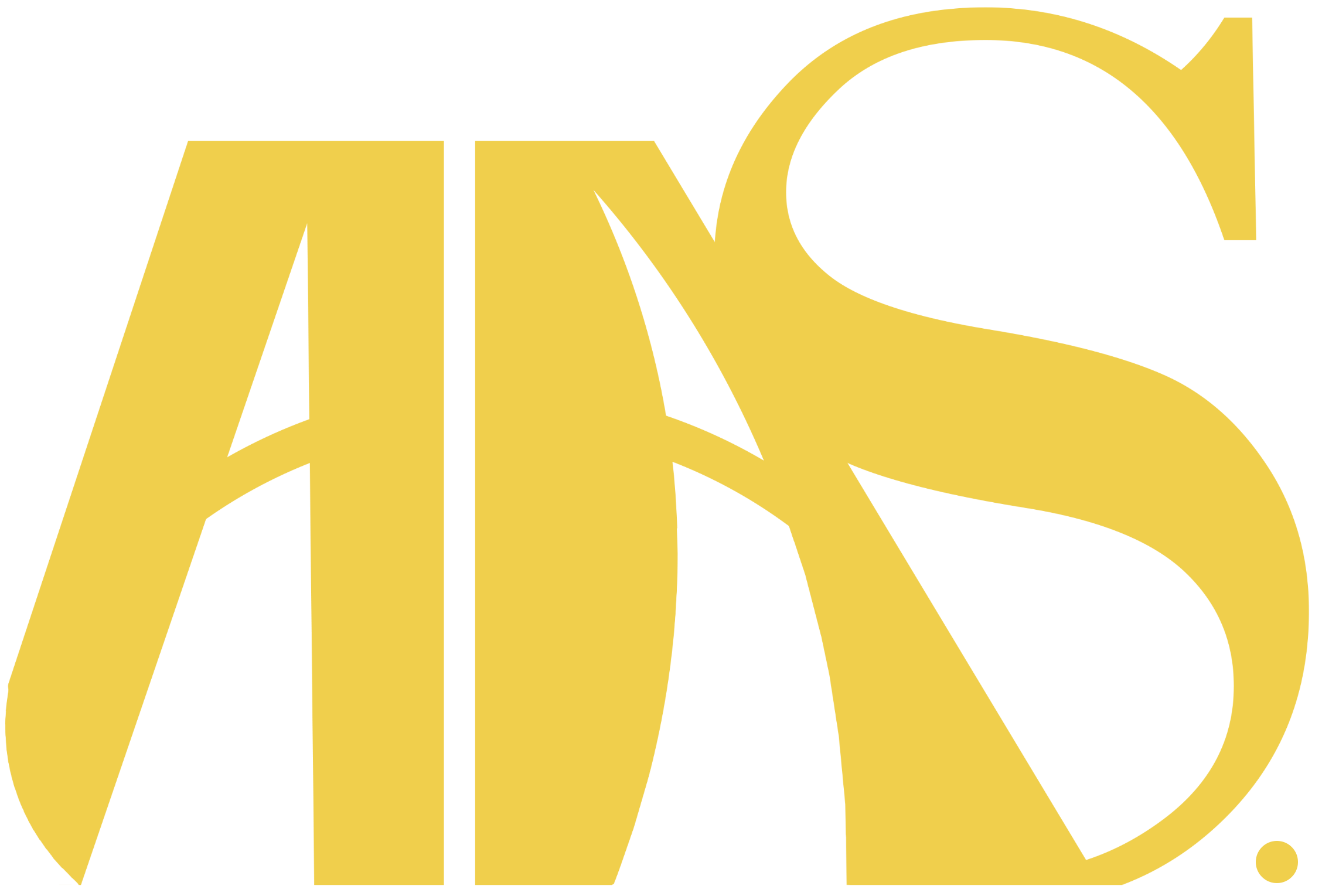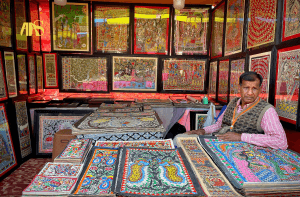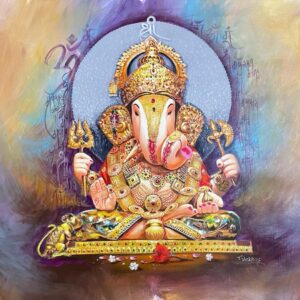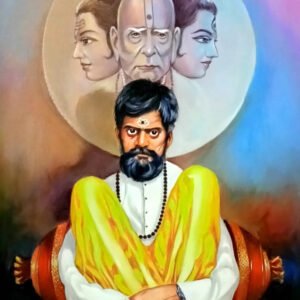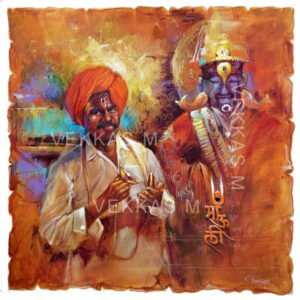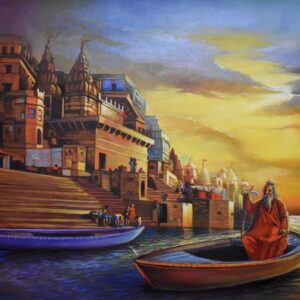Indian art stands as one of humanity’s oldest creative traditions, weaving together 5,000 years of cultural evolution through paintings, sculptures, and architectural marvels.
From the intricate Mughal miniatures to bold Madhubani folk art, Indian artwork captures spiritual devotion, royal grandeur, and daily life’s vibrant rhythms.
The rich tapestry of Indian art offers both collectors and enthusiasts an unparalleled opportunity to own pieces that blend historical significance with aesthetic beauty.
Whether you’re drawn to traditional Tanjore paintings with their distinctive gold leaf work or contemporary interpretations of classical styles, understanding Indian art’s depth helps make informed purchasing decisions.
This guide explores essential Indian art forms, authentication methods, and market valuations to help you navigate the art collection journey. You’ll discover how to identify genuine pieces, understand their cultural context, and make sound investment choices in various price ranges.

Brief Overview of Major Indian Art Traditions
The classical period gave birth to iconic styles like Ajanta cave paintings and Chola bronze sculptures. These masterpieces showcase sophisticated techniques that continue to influence modern artists.
Religious themes dominate classical works, depicting Hindu deities, Buddhist narratives, and Jain symbolism through established artistic conventions.
Folk Art Traditions
Folk art emerges from India’s diverse regional communities, each with distinct styles and storytelling methods.
Madhubani paintings from Bihar feature geometric patterns and natural dyes, while Maharashtra’s Warli art uses simple white pigments to depict tribal life. These traditions maintain their authenticity while adapting to contemporary market demands.
Modern Interpretations
Today’s Indian artists reinterpret traditional themes through modern mediums and perspectives.
This fusion creates unique investment opportunities for collectors seeking both cultural significance and contemporary appeal.
Digital techniques and mixed media approaches expand the definition of Indian artwork while honoring its historical roots.
The Evolution of Indian Art
The story of Indian art unfolds across millennia, revealing artistic innovations that shaped global cultural heritage.
Archaeological discoveries and preserved artworks document this remarkable journey from ancient civilizations to medieval artistic splendor.
Ancient Beginnings
The Indus Valley Civilization marked the birth of Indian artistic expression around 3300 BCE. Excavations at Mohenjo-daro and Harappa reveal sophisticated bronze sculptures, terracotta figurines, and intricate seals.
The famous “Dancing Girl” bronze statuette exemplifies the advanced metallurgy and artistic vision of this era.
Buddhist art emerged as a dominant force in 200 BCE, introducing new artistic conventions. The stupas of Sanchi and Amaravati showcase elaborate relief sculptures narrating Buddha’s life stories.
Artists developed unique visual languages to represent Buddhist teachings, creating medallions, friezes, and narrative panels that adorned religious architecture.
Jain patronage enriched Indian art through detailed manuscript illustrations and temple decorations.
The caves of Ellora and Elephanta display remarkable examples of early Hindu art forms, where sculptors carved entire temples from solid rock, creating masterpieces like the Kailasa Temple.
Featured products
Adhikaranandin
Add to cart₹26,785.71 Tax InclusiveBring Divine Into Your Home with Our Handcrafted Mahadev & Nandi Painting
Select optionsPrice range: ₹20,920.54 through ₹288,083.93 Tax InclusiveBuddha With Lotus
Add to cart₹8,562.50 Tax InclusiveDagdusheth Ganapati Painting | Canvas Painting
Select optionsPrice range: ₹11,383.93 through ₹20,241.07 Tax Inclusive
Classical Period
The Mauryan Empire (322-185 BCE) established India’s first imperial art style. Emperor Ashoka’s pillars, crowned with magnificent lion capitals, demonstrate sophisticated stone carving techniques.
The famous Sarnath Lion Capital, now India’s national emblem, reflects the period’s artistic excellence.
Under the Gupta Dynasty (320-550 CE), Indian art reached new heights. Artists perfected the representation of divine figures, creating idealized forms that combined spiritual symbolism with naturalistic details.
The Buddha images from Sarnath embody this artistic mastery, featuring serene expressions and flowing drapery that influenced Buddhist art across Asia.
Religious structures saw remarkable artistic developments. Temple walls became canvases for sculptural narratives, while bronze casters produced exquisite deity figures.
Secular art flourished simultaneously, with court scenes and daily life depictions enriching palace walls and manuscripts.
Medieval Developments
Islamic artistic traditions entered India through successive dynasties, introducing new aesthetic sensibilities. Persian miniature painting techniques merged with Indian styles, creating the distinctive Indo-Persian school.
The Delhi Sultanate period saw the emergence of Islamic architectural decoration featuring geometric patterns and calligraphy.
Regional artistic centers developed unique styles. Gujarat specialized in manuscript painting, while Bengal evolved its distinctive temple architecture. Kashmir became renowned for bronze casting, and Rajasthan developed its school of miniature painting.
The synthesis of various traditions created new artistic vocabularies.
The Mughal atelier combined Persian miniature techniques with Indian naturalism, producing masterpieces like the Hamzanama. Hindu kingdoms adapted Islamic decorative elements while maintaining their indigenous artistic traditions.
This artistic evolution continues to influence contemporary Indian artists, who draw inspiration from these rich traditions while creating modern interpretations.
Collectors particularly value pieces that demonstrate clear links to these historical periods, as they represent crucial developments in Indian artistic expression.
- Development of stone sculpture techniques
- Evolution of bronze casting methods
- Refinement of painting styles
- Integration of diverse cultural influences
- Creation of new iconographic traditions
The understanding of these evolutionary phases helps collectors identify significant pieces and appreciate their historical context. This knowledge proves essential for making informed acquisition decisions in today’s art market.
Major Traditional Art Forms
Indian art traditions represent some of the world’s most sophisticated artistic achievements. Each style carries distinct characteristics that determine its market value and collector appeal. Understanding these traditions helps buyers identify authentic pieces and make informed investment decisions.
Classical Painting Styles
Mughal miniature paintings stand among India’s most valued art forms. Created between the 16th and 19th centuries, these detailed works feature fine brushwork and precious mineral colors.
Original Mughal miniatures command high prices at auctions, with rare pieces fetching upwards of $50,000. Modern reproductions, while more accessible, still require careful authentication.
Rajasthani paintings emerged from royal courts, featuring bold colors and elaborate details. These works typically depict royal scenes, religious themes, and romantic narratives.
Collectors prize pieces from established schools like Kishangarh and Mewar, where prices range from $5,000 to $25,000 for authenticated works.
Tanjore paintings, distinguished by their use of gold leaf and precious stones, originated in South India. Traditional pieces feature Hindu deities against ornate backgrounds. Current market values vary:
- Antique pieces (pre-1900): $10,000-30,000
- Mid-century works: $2,000-8,000
- Contemporary pieces: $500-2,000
Folk Art Traditions
Madhubani paintings from Bihar reflect centuries-old traditions passed through generations. These works use natural pigments and geometric patterns to tell mythological stories. The market recognizes several quality levels:
- Master artist works: $1,000-5,000
- Traditional artist pieces: $200-800
- Training works: $50-150
Warli art from Maharashtra uses simple white pigments on earthen-colored surfaces. These tribal paintings depict daily life scenes and ritual celebrations. Authentication factors include:
- Artist lineage
- Traditional material use
- Design complexity
Current prices range from $100 for small contemporary pieces to $3,000 for large masterworks.
Gond paintings feature distinctive patterns and nature-inspired motifs. Modern Gond artists have gained international recognition, increasing market values:
- Established artists: $2,000-10,000
- Emerging artists: $500-1,500
- Community works: $100-400
Sculptural Arts
Bronze casting reaches back to the Chola period, with techniques passed down through generations. Modern bronze sculptures maintain strict traditional standards:
Quality Indicators:
- Metal composition
- Casting precision
- Surface finishing
- Artistic detail
Investment ranges:
- Museum-quality pieces: $25,000+
- Collection-grade works: $5,000-20,000
- Decorative pieces: $1,000-4,000
Stone carving traditions continue in centers like Mahabalipuram. Contemporary sculptors create both traditional and modern designs. Valuation depends on:
- Stone quality
- Carving complexity
- Artist reputation
- Size and weight
Temple architectural elements attract specialized collectors. Original pieces rarely enter the market, making authenticated antique elements highly valuable.
Modern architectural pieces offer more accessible entry points:
- Antique elements: $50,000+
- Vintage pieces: $10,000-40,000
- Contemporary works: $2,000-8,000
Investment Considerations:
- Verify artist credentials
- Check material authenticity
- Obtain certification documentation
- Research market trends
- Consider preservation requirements
- Artist/Workshop verification
- Material analysis
- Style consistency
- Historical documentation
- Expert validation
Modern collectors increasingly value traditional art forms that maintain historical accuracy while meeting contemporary quality standards.
Each category offers investment opportunities across various price points, allowing collectors to build meaningful collections based on their interests and budget.
Regional Art Traditions
Indian regional art traditions reflect distinct cultural identities, offering collectors unique investment opportunities. Each region developed specialized techniques and styles that continue to influence contemporary artists and determine market values.
Top rated products
Vakratund Ganesha Painting – Original Spiritual Vastu Art on Canvas
Select optionsPrice range: ₹13,333.04 through ₹16,294.64 Tax InclusiveShankar Maharaj Painting
Select optionsPrice range: ₹12,053.57 through ₹20,982.14 Tax InclusiveBring Divine Into Your Home with Our Handcrafted Mahadev & Nandi Painting
Select optionsPrice range: ₹20,920.54 through ₹288,083.93 Tax InclusiveVitthal 2
Add to cart₹14,901.79 Tax InclusiveGhats of Varanasi | The City of Gods
Add to cartOriginal price was: ₹20,089.29.₹13,839.29Current price is: ₹13,839.29. Tax Inclusive
North Indian Styles
The northern regions developed sophisticated artistic traditions under royal patronage. The Pahari school of painting, originating in the Himalayan kingdoms, creates works that regularly achieve significant auction prices.
Notable North Indian styles include:
Kangra Paintings
- Known for delicate brushwork and nature themes
- Prices range from $3,000 to $15,000
- Highly valued for romantic themes and Krishna narratives
Lucknow School
- Famous for detailed court scenes
- Investment value: $4,000-20,000 for authenticated pieces
- Distinctive for its Persian influences and refined techniques
South Indian Schools
Southern India’s art traditions emphasize religious themes and classical forms. These styles maintain strict traditional guidelines, making authentication easier for collectors.
Mysore Painting Tradition
- Gold leaf work on solid backgrounds
- Traditional pieces: $2,500-12,000
- Modern works: $500-3,000
- Valued for religious themes and royal portraits
Kerala Mural Tradition
- Natural pigments on temple walls
- Contemporary adaptations: $1,000-5,000
- Characterized by bold lines and vibrant colors
Eastern Indian Art Forms
Eastern India’s artistic heritage combines folk elements with classical traditions. These regions produce distinctive styles that attract specialized collectors.
Pattachitra Style
- Traditional scroll paintings from Odisha
- Antique scrolls: $3,000-15,000
- Contemporary works: $200-2,000
- Valued for storytelling elements and natural colors
Bengal School
- Modern interpretations of traditional themes
- Investment grade pieces: $5,000-25,000
- Known for watercolor techniques and nationalist themes
Western Indian Traditions
Western India’s art forms blend maritime trade influences with local traditions. These styles often incorporate unique materials and techniques.
Gujarat Traditions
- Miniature painting schools
- Pichhwai paintings: $1,000-8,000
- Distinctive for cloth painting and architectural details
Maharashtra Heritage
- Traditional wall paintings
- Contemporary adaptations: $500-4,000
- Known for religious themes and community participation
Market Value Determinants:
- Regional authenticity
- Traditional technique adherence
- Artist training lineage
- Material quality
- Historical documentation
Regional Art Collection Strategy:
- Focus on established regional centers
- Verify artist training background
- Document traditional technique use
- Consider preservation requirements
- Research market demand trends
Authentication Considerations:
- Regional style characteristics
- Traditional material use
- Artist community connections
- Historical documentation
- Expert verification
Modern Market Trends:
- Growing interest in regional styles
- Increased international recognition
- Rising values for authenticated pieces
- Emerging contemporary interpretations
- Strong collector demand
Storage and Display Requirements:
- Climate control needs
- Light exposure limitations
- Handling protocols
- Insurance considerations
- Display recommendations
Each regional tradition maintains specific quality standards that influence market values.
Collectors should consider these factors when building their collections:
Quality Indicators:
- Material authenticity
- Technical execution
- Style consistency
- Artistic innovation
- Historical accuracy
Factors Affecting Regional Art Values:
- Historical significance
- Technical excellence
- Artist reputation
- Market demand
- Conservation status
Understanding regional variations helps collectors identify valuable pieces and make informed investment decisions. These traditions continue to evolve, creating new opportunities for art investment while maintaining their cultural significance.
Contemporary Indian Art Scene
The modern Indian art market shows remarkable growth, with prices reaching record levels at international auctions.
New artistic expressions blend traditional elements with contemporary perspectives, creating valuable investment opportunities for collectors.
Modern Masters
Today’s leading Indian artists command significant market attention. Their works represent secure investment opportunities while influencing emerging artists’ valuations.
Notable Artists and Market Values:
M.F. Husain
- Paintings range from $100,000 to $2 million
- Strong auction performance history
- Consistent value appreciation
- High collector demand worldwide
S.H. Raza
- Geometric abstracts: $200,000-1.5 million
- Regular auction presence
- Established collector base
- Verified authentication processes
Tyeb Mehta
- Major works exceed $3 million
- Limited available pieces
- Strong investment potential
- Regular museum acquisitions
Investment Considerations:
- Established market presence
- Documentation completeness
- Exhibition history
- Condition reports
- Provenance verification
Emerging Trends
Digital innovations and new media reshape India’s art landscape. These developments create fresh collecting opportunities across various price points.
Digital Art Movements
- NFT collections: $1,000-50,000
- Digital prints: $500-5,000
- Virtual reality installations: $5,000-25,000
Market Impact:
- Growing collector interest
- New authentication methods
- Digital ownership verification
- Emerging platforms for sales
Mixed Media Innovations
Price Ranges:
- Established artists: $10,000-100,000
- Mid-career artists: $5,000-25,000
- Emerging talents: $1,000-8,000
Technical Elements:
- Traditional material integration
- Digital components
- Interactive elements
- Sustainable materials
The contemporary Indian art scene offers diverse investment entry points. Collectors can build significant portfolios by understanding market dynamics and emerging trends while maintaining focus on quality and documentation.
The Future of Indian Artwork: A Legacy in Motion
Indian artwork stands at a pivotal moment, bridging centuries of artistic tradition with contemporary global influences. The market shows strong growth potential across all segments, from traditional Tanjore paintings to cutting-edge digital installations.
For collectors, the current market presents strategic opportunities. Traditional art forms maintain steady value appreciation, with authenticated pieces from established traditions commanding premium prices.
Meanwhile, contemporary artists create innovative works that attract international attention and investment.
Key Investment Considerations:
- Traditional pieces offer stable long-term value
- Contemporary works show dynamic market growth
- Regional art provides unique collection opportunities
- Digital innovations create new market segments
The future of Indian art points toward increased global recognition and value appreciation. Market indicators suggest continued growth in both traditional and contemporary segments, supported by:
- Strong international auction performance
- Growing collector base worldwide
- Increased institutional support
- Enhanced authentication methods
- Digital market expansion
For those considering Indian art investment, now presents an opportune time to enter the market. Whether focusing on traditional masterpieces or contemporary innovations, the key lies in thorough authentication, proper documentation, and relationship building with reputable galleries and dealers.
Take the first step in your collection journey by connecting with established galleries, attending major art fairs, and consulting with recognized experts in Indian art. The richness of India’s artistic heritage awaits your participation in its continuing story.

